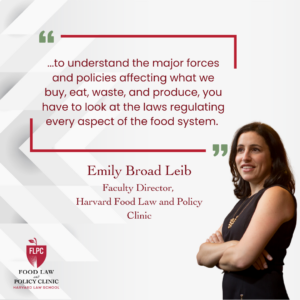The coronavirus pandemic exposed major long-standing problems in the U.S. food system. Harvard and Vermont Law Schools’ “Urgent Call for a U.S. National Food Strategy: An Update to the Blueprint” identifies a framework to create more effective and coordinated policy solutions.
The COVID-19 pandemic brought the U.S. food system to the brink of catastrophic collapse, but the problems exposed were present long before the coronavirus arrived in the United States.
For years, food policy experts have warned of a crisis in the nation’s food system, which is riddled with weaknesses, inefficiencies, and injustices and suffers from an arcane and fragmented regulatory regime. Government shutdowns and the public health impacts of COVID-19 exacerbated and turned a spotlight on many long-standing problems.
“The major food system challenges made so obvious by COVID-19—soaring rates of food insecurity, disproportionate impacts to underserved and BIPOC communities, inadequately protected food system workers, staggering amounts of lost income for farmers, and enormous food waste—already existed before the pandemic at crisis levels, “ said Laurie Beyranevand, Director of the Center for Agriculture and Food Systems and Professor of Law at Vermont Law School. “These injustices and failures persist because we lack formal structures for coordination making federal solutions piecemeal, incremental and responsive, rather than comprehensive, strategic, and proactive.”
A national food strategy would provide a framework to identify and address these shortcomings and encourage a transition to a more just, fair, efficient, and economically-resilient food system.
Today, Vermont Law School’s Center for Agriculture and Food Systems (CAFS) and Harvard Law School’s Food Law and Policy Clinic (FLPC) released “The Urgent Call for a U.S. National Food Strategy: An Update to the Blueprint.” Given the worsening challenges facing the food system—current threats like the COVID-19 pandemic and long term threats like climate change— CAFS and FLPC advocate for a coordinated approach to policymaking that helps identify our national food system priorities and provides opportunities for stakeholders and the public to give feedback on how to navigate the tradeoffs inherent in food policymaking.
The United States currently lacks a mechanism to address the interconnected economic, health, environmental, and equity issues inherent in the food system. Instead, the American food system is governed by a poorly-coordinated patchwork of federal, state, tribal, and local laws, administered by agencies with overlapping duties that result in inefficiencies and yield unintended consequences. A coordinated strategy at the federal level would streamline food system policy.
“If we are going to solve the issues plaguing our food system, we will need commitment and coordination from all levels and branches of government, and participation from a diverse range of stakeholders, including farm and food system workers, advocates that regularly address food insecurity and environmental issues, and the general public,” said Emily Broad Leib, Faculty Director of FLPC and Clinical Professor of Law at Harvard Law School. “We have seen this sort of cohesive national action before with the response to 9/11 and with the National Strategy for HIV/AIDS. The COVID-19 pandemic has unearthed a food crisis that merits a similar response, a response that will also work to address long-standing inequities in our food system well beyond the current crises,” Broad Leib concluded.
The new report builds on the Blueprint for a National Food Strategy, a roadmap for how the federal government can and should develop a U.S. national food strategy, published by FLPC and CAFS in 2017. Since then, some federal agencies have taken incremental steps to coordinate on discrete food system issues, but no initiative has led to a comprehensive strategy for coordinating policies that impact the food system.
The Urgent Call for a U.S. National Food Strategy: An Update to the Blueprint revisits other national strategies that provide guidance and concrete examples for building a national food strategy. It provides updates on food strategies in those countries, including an accelerated approach in the United Kingdom, and the launch of a new coordinated national food policy in Canada. The updated report also examines the stresses put on the U.S. food system by the coronavirus pandemic, emphasizing how the government’s fragmented and delayed response reflects the ongoing problems related to uncoordinated food system planning and policymaking.
The report recommends that a national food strategy incorporate the following principles:
- Leadership and interagency coordination to draft and implement the strategy.
- Participation from state and local governments and a diverse range of stakeholders.
- Transparency, accountability, and enforceability in the national food strategy drafting and implementation.
- Durability to maintain focus on long-term priorities and withstand changes in the presidential administration and Congress.
The full report can be viewed at http://foodstrategyblueprint.org.


Health Law & Policy, Commentary
Braidwood Management v. Becerra: Updated FAQs for Health Advocates and Providers
July 22, 2024